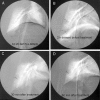The effect of the fibrinolytic enzyme FIIa from Agkistrodon acutus venom on acute pulmonary thromboembolism
- PMID: 21293476
- PMCID: PMC4009945
- DOI: 10.1038/aps.2010.193
The effect of the fibrinolytic enzyme FIIa from Agkistrodon acutus venom on acute pulmonary thromboembolism
Abstract
Aim: To evaluate the effects of the fibrinolytic enzyme FII(a) from Agkistrodon acutus venom on acute pulmonary thromboembolism (APT) in animal models.
Methods: Both rabbit and dog APT models were used. For the rabbit APT model, the thrombi weight before and after administration was measured. Central venous pressure (CVP) and mean arterial pressure (MAP) were measured before and 15, 30, 60, and 120 min after the injection of the blood clot. Partial thromboplastin time (APTT), prothrombin time (PT), platelet count, and fibrinogen concentration were measured using auto analyzers. Plasminogen activity was measured based on chromogenic substrates. In the dog APT model, pulmonary blood flow was recorded using pulmonary angiography.
Results: Intravenous administration of FIIa (0.1-5.0 mg/kg) improved the APT-induced hemodynamic derangements and reduced thrombi weight. The angiography evidence also showed that the pulmonary emboli had almost disappeared after FII(a) infusion. FII(a) (0.1, 0.5, or 1.0 mg/kg) did not impair the coagulation pathways, although very high doses of FII(a) (5.0 mg/kg) could stimulate the production of plasminogen and result in impairment of the pathways.
Conclusion: FII(a) could effectively protect against APT via degradation of thrombi with less activation of plasminogen, and may provide a novel fibrinolytic enzyme for targeting the main pathological processes of the disease.
Figures



References
-
- Keymel S, Rassaf T, Kelm M. Nitrite in action: a commentary on “Low-dose intravenous nitrite improves hemodynamics in a canine model of acute pulmonary thromboemolism. Free Radic Biol Med. 2006;41:1750–2. - PubMed
-
- Cushman M, Tsai AW, White RH, Heckbert SR, Rosamond WD, Enright P, et al. Deep vein thrombosis and pulmonary embolism in two cohorts: the longitudinal investigation of thromboembolism etiology. Am J Med. 2004;117:19–25. - PubMed
-
- Goldhaber SZ, Visani L, De Rosa M. Acute pulmonary embolism: clinical outcomes in the International Cooperative Pulmonary Embolism Registry (ICOPER) Lancet. 1999;353:1386–9. - PubMed
-
- Barritt DW, Jordon SC. Anticoagulant drugs in the treatment of pulmonary embolism: a controlled trial. Lancet. 1960;1:1309–12. - PubMed
-
- Hull R, Delmore T, Centon E, Hirsh J, Gent M, Sackett D, et al. Warfarin sodium versus low-dose heparin in the long-term treatment of venous thrombosis. N Engl J Med. 1979;301:855–8. - PubMed
Publication types
MeSH terms
Substances
LinkOut - more resources
Full Text Sources
Medical

